人教版(2019)选择性必修第一册.Unit3 Fascinating Parks DiscoveringUseful Structures动词ing课件(16张ppt)
文档属性
| 名称 | 人教版(2019)选择性必修第一册.Unit3 Fascinating Parks DiscoveringUseful Structures动词ing课件(16张ppt) | 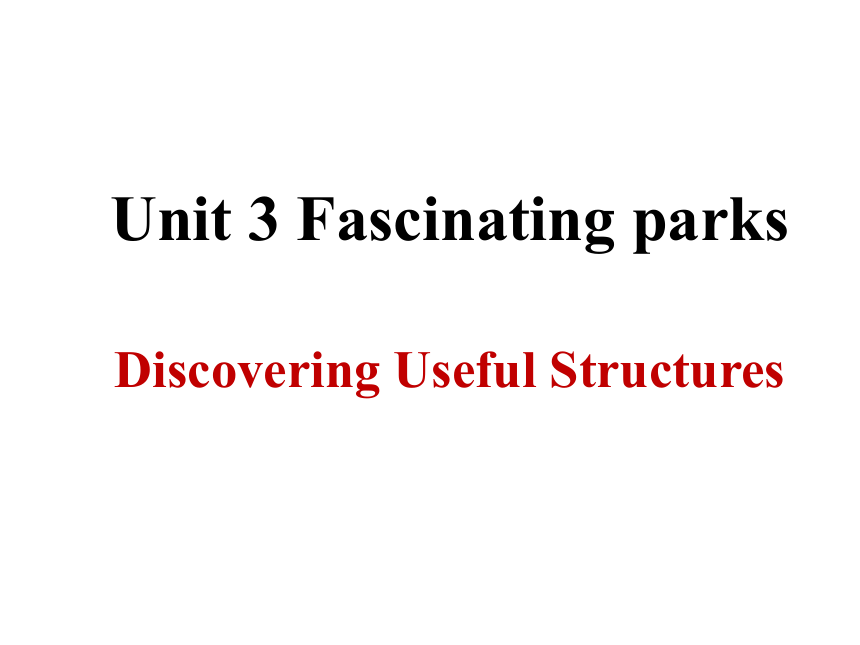 | |
| 格式 | zip | ||
| 文件大小 | 583.5KB | ||
| 资源类型 | 教案 | ||
| 版本资源 | 人教版(2019) | ||
| 科目 | 英语 | ||
| 更新时间 | 2022-03-23 19:06:55 | ||
图片预览


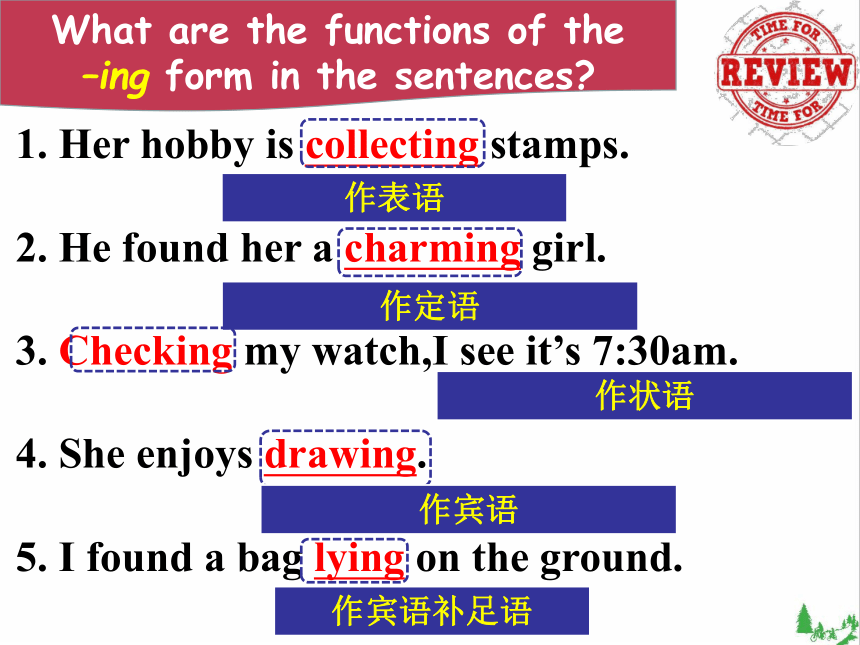
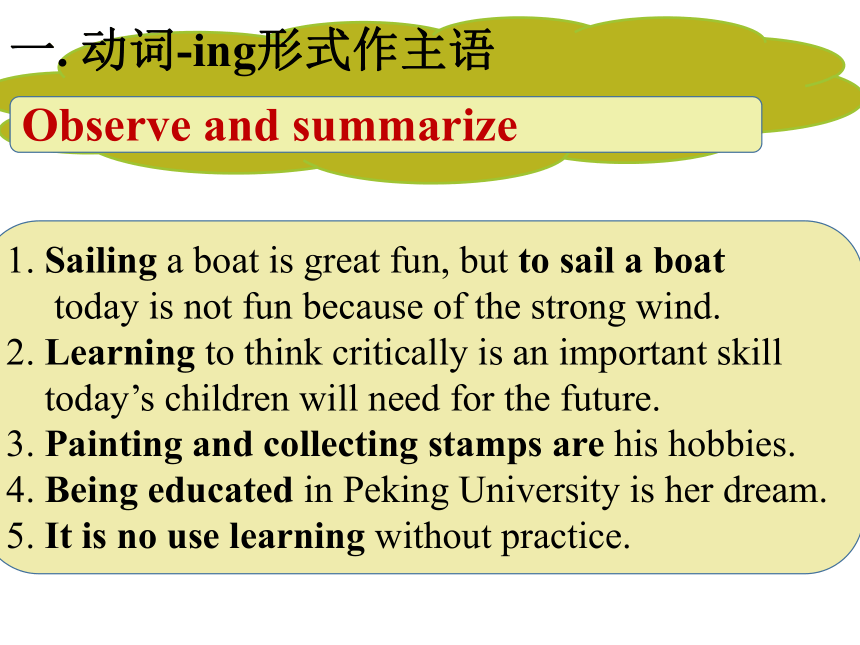
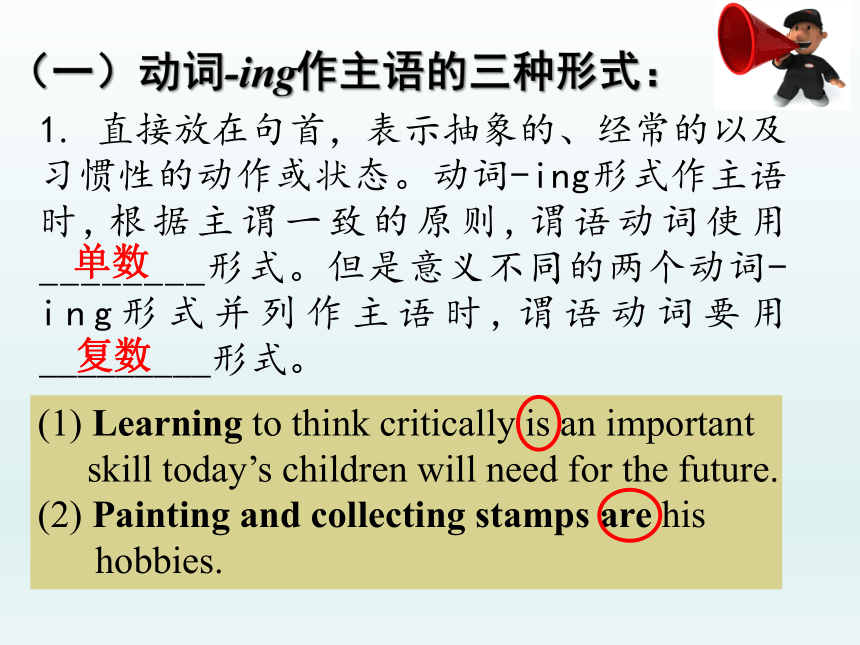

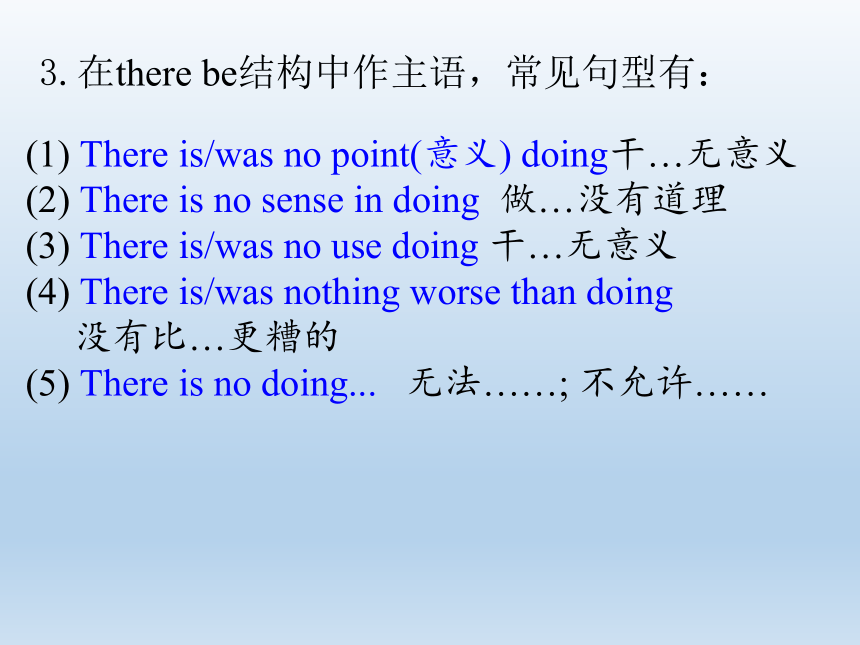
文档简介
(共16张PPT)
Discovering Useful Structures
Unit 3 Fascinating parks
learning objectives
1. Students can recognize and summarize
the function and meaning of the -ing
form as the subject, the object and the
predicative.
2. Students can use the -ing form as the
subject, the object and the predicative
flexibly in writing.
1. Her hobby is collecting stamps.
2. He found her a charming girl.
3. Checking my watch,I see it’s 7:30am.
4. She enjoys drawing.
5. I found a bag lying on the ground.
What are the functions of the
–ing form in the sentences
作表语
作定语
作状语
作宾语
作宾语补足语
一. 动词-ing形式作主语
Observe and summarize
1. Sailing a boat is great fun, but to sail a boat
today is not fun because of the strong wind.
2. Learning to think critically is an important skill
today’s children will need for the future.
3. Painting and collecting stamps are his hobbies.
4. Being educated in Peking University is her dream.
5. It is no use learning without practice.
(一)动词-ing作主语的三种形式:
1. 直接放在句首,表示抽象的、经常的以及习惯性的动作或状态。动词-ing形式作主语时,根据主谓一致的原则,谓语动词使用________形式。但是意义不同的两个动词-ing形式并列作主语时,谓语动词要用_________形式。
(1) Learning to think critically is an important
skill today’s children will need for the future.
(2) Painting and collecting stamps are his
hobbies.
单数
复数
2. it在句首作形式主语,动词-ing形式后置作真正的主语,用形容词或名词作表语,如useful,useless, good, fun, no use, worthwhile等。。
形式主语it代替动词-ing形式作主语的常见句型:
(1) It is a waste of+time/money+doing sth.
做某事是浪费时间/金钱。
(2) It is no+use/good/fun+doing sth.
做某事没有用/没有好处/不好玩。
(3) It is useless/worthwhile ...+doing sth.
做某事是没有用的/值得的……
(4) It is/was hardly/scarcely worth doing
做……不值得
3.在there be结构中作主语,常见句型有:
(1) There is/was no point(意义) doing干…无意义
(2) There is no sense in doing 做…没有道理
(3) There is/was no use doing 干…无意义
(4) There is/was nothing worse than doing
没有比…更糟的
(5) There is no doing... 无法……; 不允许……
注意:
1. 动词-ing形式和不定式都可以用作_______。动词-ing形式往往表示经常的、习惯性的动作或状态,而不定式常表示某次具体的行为。
2. 如果作主语的动词表示被动意义,那么使用____________作主语。
3. 动词-ing的否定形式是在其前面直接加上_____,带有逻辑主语时,not 应放在逻辑主语和-ing 形式之间。
主语
being done
not
【观察思考】
1. Their failing in the examination made them all disappointed.
2. Kate’s leaving made everyone sad.
【探究总结】
动词-ing形式的复合结构作主语时有两种形式:
1.形容词性 +动词-ing形式;
2. +动词-ing形式。
(二)动词-ing的复合结构作主语
物主代词
名词所有格
二. 动词-ing形式作宾语
Observe and summarize
1. I quickly lower myself, ducking my head to avoid
looking directly into his eyes.
2. A 90-year-old has been awarded “Woman of the
Year” for being Britain’s oldest full-time employee.
3. The squirrel was lucky that it just missed being
caught.
4. Doctors suggest not eating junk food to stay healthy.
5. Do you mind me/my taking photos here
动词-ing作宾语的三种形式:
1.有些动词或短语动词只接-ing形式作宾语,不能接不定式。如:
考虑建议盼原谅,承认推迟没得想,避免错过继续练, 否认完成停享赏, 不禁介意准逃亡,不准冒险凭想象。 consider, suggest/advise, look forward to, excuse, pardon, admit, delay /put off , fancy, avoid, miss, keep /keep on , practice, deny, finish, stop, enjoy/ appreciate, can’t help, mind, allow/permit, escape, forbid , risk , imagine
2. _______后面一般用动词-ing形式作宾语。 如:devote to, object to, pay attention to, get down to, lead to, look forward to, stick to, be used to, devote oneself to等。
3.有些动词既可以接动词-ing形式作宾语,又可以接不定式作宾语,但表示的意义不同,常见如下:
remember doing 记得做过某事
to do 记得要做某事
forget doing 忘记做过某事
to do 忘记要做某事
regret doing 后悔做过某事
to do 遗憾要做某事
stop doing 停止正在做的事情
to do 停下来去做另一件事
mean doing 意味着做某事
to do 打算做某事
介词
注意:
1. 用作宾语的动词-ing形式如果表示被动意义,那么应该使用_________________。
2. 作宾语的动词-ing形式可以和________连用,表示否定意义。
3. 作宾语的动词-ing形式可以有自己的逻辑主语,表示动作行为的实施者。逻辑主语一般用形容词性物主代词、名词所有格或者代词宾格。
拓展:后跟动词-ing形式作宾语的动词和短语动词
建议完成多练习 suggest, finish, practise
避免错过少延期 avoid, miss, put off/delay
喜欢想象别禁止 enjoy, imagine, forbid
许可否定提建议 permit, deny, advise
考虑原谅多感激 consider, forgive, appreciate
介意冒险可抵制 mind, risk, resist
逃避幻想要坚持 escape, fancy, keep
推迟讨论早提及 postpone, discuss, mention
不喜欢承认即允许 dislike, admit, allow
情不自禁是短语 can’t help
being done
not
动名词作宾语有两种情况: 及物动词的宾语,也可作介词的宾语
三. 动词-ing形式作表语
Observe and summarize
1. Her job is keeping the lecture hall as clean as
possible, but her job today is to clean the
meeting room.
2. The problem is quite puzzling. I’m puzzled
about it.
3. What worries me most is her staying up every
night.
【探究总结】
1. 动词-ing形式作表语,用于描述________的内容,表示经常性、一般性的动作;动词不定式也可以作表语,表示某一次具体的动作。
2. 使人产生某种情绪或感觉的动词如puzzle、disappoint、excite、interest、surprise、inspire、move等的-ing形式作表语,表示主语具有的性质或状态,相当于一个形容词,意为“___________”;这些动词的-ed形式作表语,意为“感到……的”。
3. 作表语的动词-ing形式可以有自己的逻辑主语,表示动作行为的实施者。逻辑主语一般用形容词性物主代词或名词所有格。
主语
令人……的
Thank you!
Discovering Useful Structures
Unit 3 Fascinating parks
learning objectives
1. Students can recognize and summarize
the function and meaning of the -ing
form as the subject, the object and the
predicative.
2. Students can use the -ing form as the
subject, the object and the predicative
flexibly in writing.
1. Her hobby is collecting stamps.
2. He found her a charming girl.
3. Checking my watch,I see it’s 7:30am.
4. She enjoys drawing.
5. I found a bag lying on the ground.
What are the functions of the
–ing form in the sentences
作表语
作定语
作状语
作宾语
作宾语补足语
一. 动词-ing形式作主语
Observe and summarize
1. Sailing a boat is great fun, but to sail a boat
today is not fun because of the strong wind.
2. Learning to think critically is an important skill
today’s children will need for the future.
3. Painting and collecting stamps are his hobbies.
4. Being educated in Peking University is her dream.
5. It is no use learning without practice.
(一)动词-ing作主语的三种形式:
1. 直接放在句首,表示抽象的、经常的以及习惯性的动作或状态。动词-ing形式作主语时,根据主谓一致的原则,谓语动词使用________形式。但是意义不同的两个动词-ing形式并列作主语时,谓语动词要用_________形式。
(1) Learning to think critically is an important
skill today’s children will need for the future.
(2) Painting and collecting stamps are his
hobbies.
单数
复数
2. it在句首作形式主语,动词-ing形式后置作真正的主语,用形容词或名词作表语,如useful,useless, good, fun, no use, worthwhile等。。
形式主语it代替动词-ing形式作主语的常见句型:
(1) It is a waste of+time/money+doing sth.
做某事是浪费时间/金钱。
(2) It is no+use/good/fun+doing sth.
做某事没有用/没有好处/不好玩。
(3) It is useless/worthwhile ...+doing sth.
做某事是没有用的/值得的……
(4) It is/was hardly/scarcely worth doing
做……不值得
3.在there be结构中作主语,常见句型有:
(1) There is/was no point(意义) doing干…无意义
(2) There is no sense in doing 做…没有道理
(3) There is/was no use doing 干…无意义
(4) There is/was nothing worse than doing
没有比…更糟的
(5) There is no doing... 无法……; 不允许……
注意:
1. 动词-ing形式和不定式都可以用作_______。动词-ing形式往往表示经常的、习惯性的动作或状态,而不定式常表示某次具体的行为。
2. 如果作主语的动词表示被动意义,那么使用____________作主语。
3. 动词-ing的否定形式是在其前面直接加上_____,带有逻辑主语时,not 应放在逻辑主语和-ing 形式之间。
主语
being done
not
【观察思考】
1. Their failing in the examination made them all disappointed.
2. Kate’s leaving made everyone sad.
【探究总结】
动词-ing形式的复合结构作主语时有两种形式:
1.形容词性 +动词-ing形式;
2. +动词-ing形式。
(二)动词-ing的复合结构作主语
物主代词
名词所有格
二. 动词-ing形式作宾语
Observe and summarize
1. I quickly lower myself, ducking my head to avoid
looking directly into his eyes.
2. A 90-year-old has been awarded “Woman of the
Year” for being Britain’s oldest full-time employee.
3. The squirrel was lucky that it just missed being
caught.
4. Doctors suggest not eating junk food to stay healthy.
5. Do you mind me/my taking photos here
动词-ing作宾语的三种形式:
1.有些动词或短语动词只接-ing形式作宾语,不能接不定式。如:
考虑建议盼原谅,承认推迟没得想,避免错过继续练, 否认完成停享赏, 不禁介意准逃亡,不准冒险凭想象。 consider, suggest/advise, look forward to, excuse, pardon, admit, delay /put off , fancy, avoid, miss, keep /keep on , practice, deny, finish, stop, enjoy/ appreciate, can’t help, mind, allow/permit, escape, forbid , risk , imagine
2. _______后面一般用动词-ing形式作宾语。 如:devote to, object to, pay attention to, get down to, lead to, look forward to, stick to, be used to, devote oneself to等。
3.有些动词既可以接动词-ing形式作宾语,又可以接不定式作宾语,但表示的意义不同,常见如下:
remember doing 记得做过某事
to do 记得要做某事
forget doing 忘记做过某事
to do 忘记要做某事
regret doing 后悔做过某事
to do 遗憾要做某事
stop doing 停止正在做的事情
to do 停下来去做另一件事
mean doing 意味着做某事
to do 打算做某事
介词
注意:
1. 用作宾语的动词-ing形式如果表示被动意义,那么应该使用_________________。
2. 作宾语的动词-ing形式可以和________连用,表示否定意义。
3. 作宾语的动词-ing形式可以有自己的逻辑主语,表示动作行为的实施者。逻辑主语一般用形容词性物主代词、名词所有格或者代词宾格。
拓展:后跟动词-ing形式作宾语的动词和短语动词
建议完成多练习 suggest, finish, practise
避免错过少延期 avoid, miss, put off/delay
喜欢想象别禁止 enjoy, imagine, forbid
许可否定提建议 permit, deny, advise
考虑原谅多感激 consider, forgive, appreciate
介意冒险可抵制 mind, risk, resist
逃避幻想要坚持 escape, fancy, keep
推迟讨论早提及 postpone, discuss, mention
不喜欢承认即允许 dislike, admit, allow
情不自禁是短语 can’t help
being done
not
动名词作宾语有两种情况: 及物动词的宾语,也可作介词的宾语
三. 动词-ing形式作表语
Observe and summarize
1. Her job is keeping the lecture hall as clean as
possible, but her job today is to clean the
meeting room.
2. The problem is quite puzzling. I’m puzzled
about it.
3. What worries me most is her staying up every
night.
【探究总结】
1. 动词-ing形式作表语,用于描述________的内容,表示经常性、一般性的动作;动词不定式也可以作表语,表示某一次具体的动作。
2. 使人产生某种情绪或感觉的动词如puzzle、disappoint、excite、interest、surprise、inspire、move等的-ing形式作表语,表示主语具有的性质或状态,相当于一个形容词,意为“___________”;这些动词的-ed形式作表语,意为“感到……的”。
3. 作表语的动词-ing形式可以有自己的逻辑主语,表示动作行为的实施者。逻辑主语一般用形容词性物主代词或名词所有格。
主语
令人……的
Thank you!
